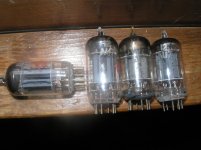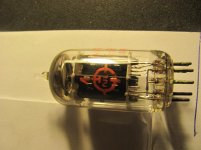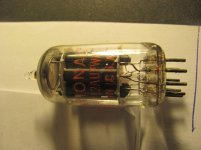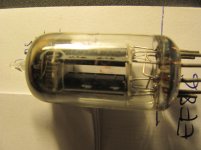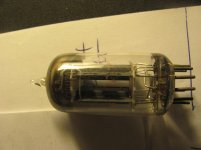Help Identifying 12au7a and 6v6 From Hammond Organ
I was looking at the back of a friends old Hammond Organ, and saw some sweet tubes. I don't know how old it is, but I'm guessing some time in the 60s.
The power tubes were Hammond branded, not sure they are that interesting. I didn't pull them all, but there were a couple 12au7a tubes in there that had no branding. they simply siad "12au7a" and "USA" in white lettering. I believe the plates were gray, but don't count on that. can anyone help identify these?
EDIT: the organ is an M-111 around 1963 by the serial number
here is the best picture I could get of the tube. the writing is very faded.
EDIT 2: this is one of the 6v6 tubes. date code suggests 1963. is it worth anything/ would it sound good in my guitar amp 😉?
I was looking at the back of a friends old Hammond Organ, and saw some sweet tubes. I don't know how old it is, but I'm guessing some time in the 60s.
The power tubes were Hammond branded, not sure they are that interesting. I didn't pull them all, but there were a couple 12au7a tubes in there that had no branding. they simply siad "12au7a" and "USA" in white lettering. I believe the plates were gray, but don't count on that. can anyone help identify these?
EDIT: the organ is an M-111 around 1963 by the serial number
here is the best picture I could get of the tube. the writing is very faded.
An externally hosted image should be here but it was not working when we last tested it.
EDIT 2: this is one of the 6v6 tubes. date code suggests 1963. is it worth anything/ would it sound good in my guitar amp 😉?
An externally hosted image should be here but it was not working when we last tested it.
Last edited:
Most likely made by General Electric.
I checked that, and all that I could find had either the GE logo, or also said ecc82 on them. Could be a special branding for Hammond though I suppose.
Thanks!
ECC82 is a European designation, GE is an American company and uses the designation 12AU7. IF you had a GE tube that says ECC82, it very well could be made in Europe by Mullard or any other company. BUT the tube you show is made by GE, I can see the little white dots that are on GE tubes. I can pull out some from my stash, I have over 100 12AU7A's made by GE pulled from Hammond Organs.
That 6V6 looks like a GE as well.
That 6V6 looks like a GE as well.
ECC82 is a European designation, GE is an American company and uses the designation 12AU7. IF you had a GE tube that says ECC82, it very well could be made in Europe by Mullard or any other company. BUT the tube you show is made by GE, I can see the little white dots that are on GE tubes. I can pull out some from my stash, I have over 100 12AU7A's made by GE pulled from Hammond Organs.
That 6V6 looks like a GE as well.
Awesome, thanks. I'm likely going to be restoring the amp in this thing, so I'll be sure to drop some picture around the forums here. The whole organ is absolutely beautiful.
I'll probably try one of those 6v6s in my homemade amp, hope it sounds as nice as it looks.
Some of the more sought after European tubes will have a special heater warm up and actually flash when the amp is powered on FWIW. European tubes will also have an acid etching on them somewhere that will tell you what plant and date they were manufactured in, B= Blackburn, Mullard etc....
Post some more pictures of the 12AU7 for others to look, other opinions are always good, I could be wrong is what I am saying lol.
Post some more pictures of the 12AU7 for others to look, other opinions are always good, I could be wrong is what I am saying lol.
Thanks for the info. Those ones look a bit different, but these things tend to differ from year to year, so who knows.
Like most companies that re-branded valves (tubes) Hammond would have bought on price.
In those days there was not the fetish & mania for bootique names.
You just bought a replacement from the local (Hammond) store.
In those days there was not the fetish & mania for bootique names.
You just bought a replacement from the local (Hammond) store.
I have several "american" 12AU7 like the ones in the photos...one is RCA and the other one is NATIONAL, but i have doubts if this National is real or a fake, has strange printings for me...
Attachments
Many of the tubes sold by National were in fact made by Sylvania, GE and RCA right at the end of the tube manufacturing era here in the U.S.A..(Late 1980s) I got a large quantity of them (National) from a former employer when they phased out tubed test equipment.
Later National also sold tubes made by Shuguang and others. The brand it appears is currently owned by Richardson Electronics, and may in fact have been in the time frame when I first ran across them.
In this time frame I suspect tubes were often made to order for third party resellers, they would commit to purchase a certain number of tubes, and the tube plant would make them. The only other significant customer by this point in time would have been the U.S. military and perhaps NASA.
Later National also sold tubes made by Shuguang and others. The brand it appears is currently owned by Richardson Electronics, and may in fact have been in the time frame when I first ran across them.
In this time frame I suspect tubes were often made to order for third party resellers, they would commit to purchase a certain number of tubes, and the tube plant would make them. The only other significant customer by this point in time would have been the U.S. military and perhaps NASA.
The power tubes from this amp were all sylvania, so It makes sense that the preamp ones would be too. Thanks for the help everyone. Hopefully I can get to keep some of these for myself. Their tonal qualities are probably better noticed in a guitar amp than the organ.
Here are some Hammond pulls I got, they are 12AX7's that I believe were made by Philips in Heerlen. Nice tubes that I am using in my HH Scott 299.
That etched triangle is the Philips Heerlen code indeed.
There should be another code for the type (I6, mC or f9 = ECC83)
The power tubes from this amp were all sylvania, so It makes sense that the preamp ones would be too. Thanks for the help everyone. Hopefully I can get to keep some of these for myself. Their tonal qualities are probably better noticed in a guitar amp than the organ.
I stand corrected. I had to dig through a bunch of tubes to compare some Sylvania and GE that I had and yes your tubes are Sylvania's. I am always getting brands, era, etc.....mixed up, especially the big American companies. A while ago I did some testing in guitar amps with various vintage brands. I made sure that out of the bunch I was testing that they tested similar in regards to transconductance. And yes I do know that the voltages are different in a guitar amp then in my Hickok 539b but whatever it was a fun little thing to do, nothing serious for I am not much of a cork sniffer. Anyway I do remember the Sylvania's to sound good through my rig. My favorites were some made by Raytheon, they had black plates and just sounded fantastic, especially when pushed! Sylvania was a close second along with RCA for American companies. In HiFi stuff I can't really tell too much of a difference between brands unless one was exceptionally strong or weak.
That etched triangle is the Philips Heerlen code indeed.
There should be another code for the type (I6, mC or f9 = ECC83)
It is hard to read on the picture I posted but on the other ones they are clearly marked I6.
- Status
- Not open for further replies.
- Home
- Amplifiers
- Tubes / Valves
- Help Identifying 12au7a From Hammond Organ
